KNIFES BAYONETS AND ALL THINGS SHARP AND POINTY.
|
WW1 Kukri Gurkha knife dated 1917. Traditional weapon of the Gurkha soldier,
unfortunately no scabbard to go with it. The picture of Gurkhas being inspected was provided by
H. D. Girdwood - and the British Library from its digital collections.
|
Pattern 1876 socket bayonet, the official name was the
"Bayonet Common Long". made by the Royal Small Arms factory Enfield,with a second pattern
Common bayonet scabbard, for the Martini Henry mk.11.
The first pattern Common bayonet scabbard of 7th June 1876 has three brass rivets running down the
center,from the 6th July 1877,the second pattern was issued with just two rivets as seen here.
|
American WW11 fighting knife made by the Cattaruagus cutlery company which was given to my Father by an American soldier during the Korean war.
|
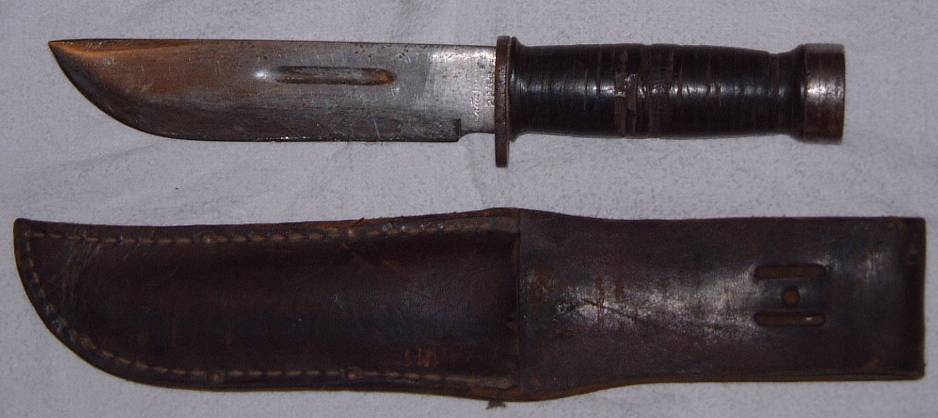 |
Number 4 spike bayonet. The number 4 spike bayonet was first approved for service in November 1939. There were four marks produced No 4 MK.1, No 4 MK.11, No 4 MK.11*, No 4 MK.111. The ones shown in the
first picture are the No 4 MK.11 and the No 4 MK.11* which was a simplified version of the MK11 with the spike being welded to the socket. The third picture is of a No 4 MK.111 Bayonet Introduced in 1943 mainly by Joseph Lucas Ltd, it
was easier and quicker to make as it was fabricated by welding seven stamped pieces of steel together then the blade was welded to the socket. The metal scabbard at the very top of the first picture is the scabbard bayonet No 4 MK 1.
There were four marks of scabbard, MK1, MK11 which looks similar to the MK.111 but made of very lightweight steel tubing and has a round frog stud, the MK111 is made of plastic with a alloy mouthpiece and a oval frog stud The forth
picture shows a lend- lease No 4 MK.11 Bayonet made by US company Stevens Savage firearms, which has a MK.111 scabbard first produced in 1943 , the MK 5 scabbard shown in pictures five and six is a lend-lease scabbard manufactured in
the united states made of plastic with an integral webbing frog riveted to the top, the makers mark is 7 VP. |
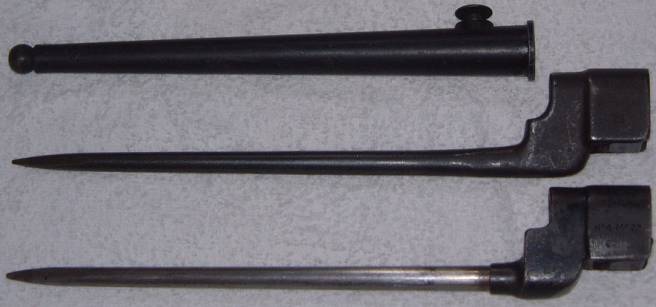 |
 |
 |
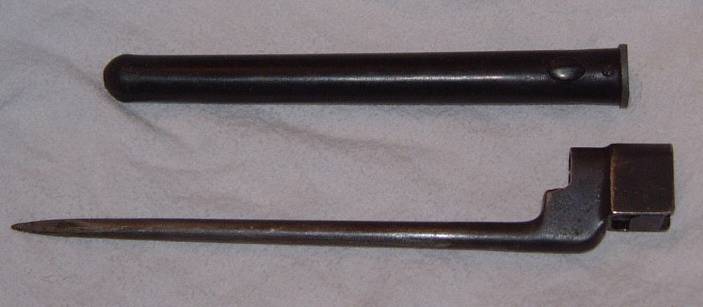 |
 |
 |
There are three types of webbing frogs used with the No 4 spike
bayonet, two were modified sword bayonet frogs using a slice in the upper webbing band and the other
a button hole the third one shown in the next picture needs a leather keeper looped over the upper
webbing band and fastened to the stud on the scabbard. |
Halberd. My father gave this to me and it was given to him by his father. Its just under two feet long and just under 10 inches wide. And weighs 10 pounds. I contacted the Leeds Armoury for an
identification, and thanks to Iason Tzouriadis, PhD Curatorial Assistant Royal Armouries Leeds for the following reply. |
The object in your possession is in my opinion and based on the images provided an ornamental halberd/staff weapon. These became particularly popular in the 19th and 20th centuries usually as part of a
larger display. The form of the weapons head was quite common in smaller battle axes, usually used by cavalry. However, when it comes to staff weapons the closest form to this is what was known throughout the 15th to 17th centuries as a mordaxt, which is a type of
halberd or pollaxe. The main identifying features of this type of weapon was the convex blade and the reinforced vertical spike.
Somewhat similar forms were used by 18th century armies (such as by the Americans, the French and the Dutch) as halberds for their sergeants.
The main element that is an indication of the later dating of your object is the form of the socket, which is too perfect and shaped like a pipe, a feature that can be found on most of these 20th century designs of staff weapons,
which are usually machine-made (or at least the socket is). Additionally, the overall weight of these weapons in the period of their use was around 2kg and that included the long wooden staff, whereas modern reproductions and
decorative weapons are often heavier. In modern ornamental designs, as your example, part of the wooden staff is often supplanted by a longer iron socket and base under the blade, and the langets, the metal strips that join the head to
the staff for practical purposes are missing. |
So from the information given to me from the Leeds Armoury and knowing how long it has been in my family I am go to say it was made early 20th century probably pre WW11. |
M1917 bayonet. It fits on the P.17 rifle in US service and the P14 rifle in British service.
It was used by the Home Guard under the Lend-Lease scheme with the USA.
Made by Remington. Dated 1917.The scabbed is dated 1918 and the blade is 17 inches long.
Thanks to Mel Dundas-Taylor for the following information. The M1917 bayonet had the two grooves in the handle to easily distinguish it by sight and feel from the Pat 1907 which appeared almost identical but the two were not interchangeable.
 |
British 1907 Pattern Bayonet dated May 1917. It was introduced as a replacement for the 1903 Pattern which was found to be too short for the new SMLE rifle. There were three versions of the 1907 during it's production. The original type had a hooked quillon (I.e. The cross guard curled round under the bayonet) and no hole in the pommel. In 1913 the hook of the quillon was removed and in 1916 a clearance hole was added to the pommel. Old types were often modified to the new specifications.This one is of the third type, with short quillon and pommel hole. Made by Sanderson Bros & Newbold Ltd, Sheffield
There were seven manufacturers involved with the production of British 1907s:
1. Wilkinson Sword Co Ltd, London
2. Sanderson Bros & Newbold Ltd, Sheffield
3. Royal Small Arms Factory, Enfield Lock
4. James A Chapman, Sheffield
5. Robert Mole & Sons, Birmingham
6. Remington Arms Union Metallic Cartridge, USA
7. Vickers Ltd, Westminster
 |
Soldiers Clasp Knifes. The larger knife at the top of the photograph was first introduced in 1905 and with some small modifications in 1913 carried on till 1939 when the smaller knifes were
introduced, the only differences between the pre WW11 knife and the WW11 knife was the size of the knife and the shape of blade plus the addition of a small flat screwdriver blade at the blade end. The larger first knife was
manufactured by Frank Mills of Sheffield, it has no legible date, the second smaller knife has no legible maker or date but is probably early war as it has a copper shackle were as the third one has a steel shackle probably to save
copper later in the war it is dated 1943 made by Richards of Sheffield. |
 |
 |
WW11 Machete with leather sheath both dated 1943.
They were not just used in jungles they were also issued as standard equipment in some vehicles.
The second picture shows the Front Near side vehicle equipment stowage diagram for an Armoured Observation Post Mk III (an artillery carrier for forward observers),
which shows the location of the Machete at top left third one down. |
Mark11 M1910 bayonet for the Canadian 303 caliber Ross Rifle.
In relic condition. Used In service during WWI then replaced by the lee-Enfield Rifle and the 1907 pattern bayonet.
Thanks two Stephen McAleer for donating this bayonet to my collection. |
No9MK.1 dated 1954 made by Enfield.
Towards the end of the World War 11 the British Authorities decided to develop a knife bayonet.
This resulted in the marriage of the socket and locking mechanism of the No 4 Spiked Bayonet
and the blade of the No 5 Bayonet. Thanks to Jim P on the War Traders Guild for this information. |
American Model M1 bayonet for the M1 Garand.
Given to my Father by an American soldier during the Korean war.
Looks to be WWII-production made by Utica Cutlery. Unfortunately It's had its handle grips replaced with wooden ones at some point
they should be a black phenolic composition with fine lines embossed perpendicular to the axis of the bayonet.
Thanks to Bill on the War Traders Guild for this information. |
Chillington Metalax' undated with MOD arrow, it has a rubber handle
which was tested up two 20,000 volts.
It was specially designed to cut through the sheet metal and Plexiglass of aircraft fuselage.
It would also so be used by civilian firemen during WW11 to deal with downed aircraft. |
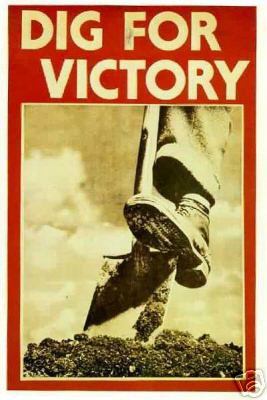 BACK TO MILITARIA EQUIPMENT. BACK TO MILITARIA EQUIPMENT. |





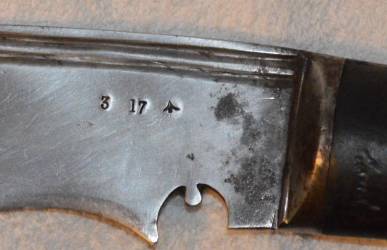
























 BACK TO MILITARIA EQUIPMENT.
BACK TO MILITARIA EQUIPMENT.